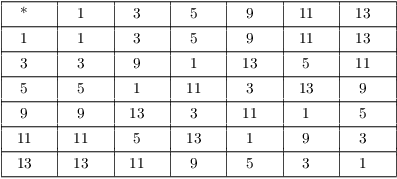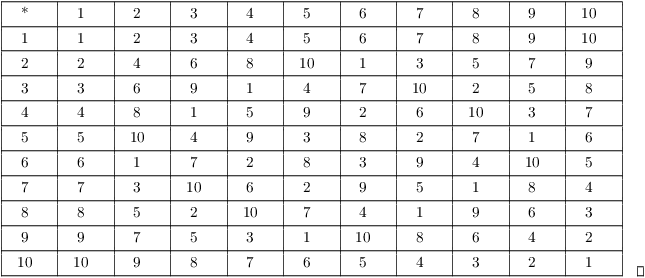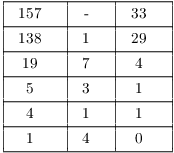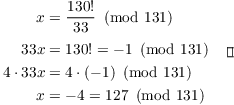The group ![]() consists of the elements
consists of the elements ![]() with addition mod n as the
operation. You can also multiply elements of
with addition mod n as the
operation. You can also multiply elements of ![]() , but you do not obtain a group: The element 0 does
not have a multiplicative inverse, for instance.
, but you do not obtain a group: The element 0 does
not have a multiplicative inverse, for instance.
However, if you confine your attention to the
units in ![]() --- the elements which have multiplicative
inverses --- you do get a group under multiplication mod n.
It is denoted
--- the elements which have multiplicative
inverses --- you do get a group under multiplication mod n.
It is denoted ![]() , and is called the group
of units in
, and is called the group
of units in ![]() .
.
Proposition. Let ![]() be the set of units in
be the set of units in
![]() ,
, ![]() . Then
. Then ![]() is a group under multiplication mod n.
is a group under multiplication mod n.
Proof. To show that multiplication mod n is a
binary operation on ![]() , I must show that the product of units is
a unit.
, I must show that the product of units is
a unit.
Suppose ![]() . Then a has a multiplicative inverse
. Then a has a multiplicative inverse ![]() and b has a multiplicative inverse
and b has a multiplicative inverse ![]() . Now
. Now
![]()
![]()
Hence, ![]() is the multiplicative inverse of
is the multiplicative inverse of ![]() , and
, and ![]() is a unit. Therefore,
multiplication mod n is a binary operation on
is a unit. Therefore,
multiplication mod n is a binary operation on ![]() .
.
(By the way, you may have seen the result ![]() when you studied linear algebra; it's a
standard identity for invertible matrices.)
when you studied linear algebra; it's a
standard identity for invertible matrices.)
I'll take it for granted that multiplication mod n is associative.
The identity element for multiplication mod n is 1, and 1 is a unit
in ![]() (with multiplicative inverrse 1).
(with multiplicative inverrse 1).
Finally, every element of ![]() has a multiplicative inverse, by
definition.
has a multiplicative inverse, by
definition.
Therefore, ![]() is a group under multiplication mod n.
is a group under multiplication mod n.![]()
Before I give some examples, recall that m is a unit in ![]() if and only if m is relatively prime to n.
if and only if m is relatively prime to n.
Example. ( The groups of
units in ![]() ) Construct a multiplication table
for
) Construct a multiplication table
for ![]() .
.
![]() consists of the elements of
consists of the elements of ![]() which are relatively prime to 14. Thus,
which are relatively prime to 14. Thus,
![]()
You multiply elements of ![]() by multiplying as if they were
integers, then reducing mod 14. For example,
by multiplying as if they were
integers, then reducing mod 14. For example,
![]()
Here's the multiplication table for ![]() :
:

Notice that the table is symmetric about the main diagonal.
Multiplication mod 14 is commutative, and ![]() is an abelian group.
is an abelian group.
Be sure to keep the operations straight: The operation in ![]() is addition mod 14, while the operation in
is addition mod 14, while the operation in
![]() is multiplication mod 14.
is multiplication mod 14.![]()
Example. ( The groups of
units in ![]() ) What are the elements of
) What are the elements of ![]() if p is a prime number?
if p is a prime number?
Construct a multiplication table for ![]() .
.
If p is prime, then all the positive integers smaller than p are relatively prime to p. Thus,
![]()
For example, in ![]() , the group of units is
, the group of units is
![]()
The operation in ![]() is multiplication mod 11. For example,
is multiplication mod 11. For example, ![]() in
in ![]() . Here's the multiplication table
for
. Here's the multiplication table
for ![]() :
:

Example. ( The subgroup
generated by an element) List the elements of ![]() in
in ![]() .
.
The elements in ![]() which are relatively prime
to 18 are the elements of
which are relatively prime
to 18 are the elements of ![]() :
:
![]()
The operation is multiplication mod 18.
Since the operation is multiplication, the cyclic subgroup generated by 7 consists of all powers of 7:
![]()
I can stop here, because ![]() mod 18. So
mod 18. So
![]()
For the next result, I'll need a special case of Lagrange's theorem: The order of an element in a finite group divides the order of the group. I'll prove Lagrange's theorem when I discuss cosets.
As an example, in a group of order 10, an element may have order 1, 2, 5, or 10, but it may not have order 8.
Theorem. ( Fermat's
Theorem) If a and p are integers, p is prime, and ![]() , then
, then
![]()
Proof. If p is prime, then
![]()
In particular, ![]() .
.
Now if ![]() , then
, then
![]()
Lagrange's theorem implies that the order of an element divides the
order of the group. As a result, ![]() in
in ![]() . Hence,
. Hence,
![]()
Example. ( Using Fermat's
Theorem to reduce a power) Compute ![]() .
.
The idea is to use Fermat's theorem to reduce the power to smaller numbers where you can do the computations directly.
97 is prime, and ![]() . By Fermat's theorem,
. By Fermat's theorem,
![]()
So
![]()
Example. 157 is prime. Reduce ![]() to a number in
to a number in ![]() .
.
By Fermat's Theorem, ![]() . So
. So
![]()
Next,

![]()
Hence, ![]() .
.
So
![]()
Here is a result which is related to Fermat's Theorem.
Theorem. ( Wilson's Theorem) p is prime if and only if
![]()
Proof. If p is prime, consider the numbers in
![]() . Note that if
. Note that if ![]() , then
, then
![]() , so
, so
![]()
Hence, ![]() , and by Euclid's lemma either
, and by Euclid's lemma either
![]() and
and ![]() or
or ![]() and
and ![]() .
.
In other words, the only two numbers in ![]() which are their own multiplicative inverses are 1 and
which are their own multiplicative inverses are 1 and ![]() . The other numbers in this set pair up as a and
. The other numbers in this set pair up as a and ![]() with
with ![]() . Hence, the product
simplifies to
. Hence, the product
simplifies to
![]()
On the other hand, if p is not prime, then p is composite. If ![]() where
where ![]() , then
, then
![]()
Thus, ![]() .
.
The only other possibility is that ![]() , where q is a
prime.
, where q is a
prime.
If ![]() , then
, then
![]()
Then both ![]() and q appear in the set
and q appear in the set ![]() , so the product
, so the product ![]() contains a factor of
contains a factor of ![]() . Once again,
. Once again, ![]() .
.
The final case is ![]() and
and ![]() . Then
. Then
![]()
Example. 131 is prime. Reduce ![]() to a number in
to a number in ![]() .
.
By Wilson's Theorem, ![]() . So
. So

Copyright 2018 by Bruce Ikenaga